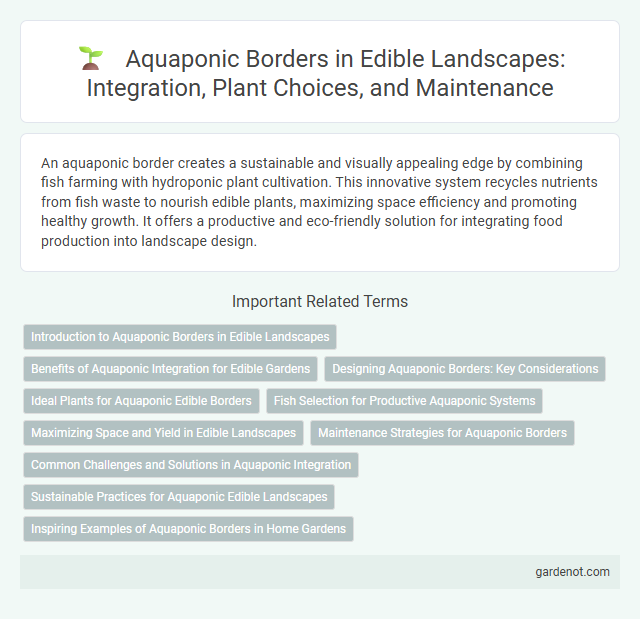An aquaponic border creates a sustainable and visually appealing edge by combining fish farming with hydroponic plant cultivation. This innovative system recycles nutrients from fish waste to nourish edible plants, maximizing space efficiency and promoting healthy growth. It offers a productive and eco-friendly solution for integrating food production into landscape design.
Introduction to Aquaponic Borders in Edible Landscapes
Aquaponic borders integrate aquaculture and hydroponics, creating a sustainable, symbiotic system where fish waste nourishes plants along garden edges. These innovative borders maximize space by combining edible crops with water-based nutrient cycling, enhancing biodiversity and yield in urban or small-scale edible landscapes. Aquaponic borders offer efficient water use, reduce chemical inputs, and support year-round production of fresh herbs, leafy greens, and vegetables.
Benefits of Aquaponic Integration for Edible Gardens
Aquaponic borders enhance edible gardens by combining aquaculture and hydroponics, creating a sustainable ecosystem that reduces water usage by up to 90%. This integration boosts plant growth through nutrient-rich fish effluent, improving crop yields and quality. Additionally, aquaponic systems minimize chemical fertilizers and pesticides, promoting healthier, organic produce.
Designing Aquaponic Borders: Key Considerations
Designing aquaponic borders requires balancing plant species selection with fish tank size to optimize nutrient exchange and water quality. Incorporate native, fast-growing, and edible plants that thrive in wet conditions, such as watercress and mint, to boost system sustainability. Ensure proper spacing and structural support to facilitate efficient water flow and maximize sunlight exposure for healthy plant growth.
Ideal Plants for Aquaponic Edible Borders
Ideal plants for aquaponic edible borders include leafy greens such as lettuce, spinach, and kale, which thrive in nutrient-rich water and grow quickly to provide continuous harvests. Herbs like basil, mint, and chives also perform exceptionally well in aquaponic systems due to their compact size and rapid growth cycles. Fruit-bearing plants such as strawberries and cherry tomatoes can be integrated into edible borders, benefiting from the consistent moisture and nutrients supplied by aquaponic technology.
Fish Selection for Productive Aquaponic Systems
Selecting appropriate fish species is crucial for maintaining a productive aquaponic system, as species like tilapia, catfish, and trout are well-suited due to their rapid growth rates and adaptability to various water conditions. Herbal water quality parameters such as temperature, pH, and dissolved oxygen must align with the fish species' needs to optimize nutrient cycling and enhance plant growth in edible landscapes. Proper fish selection directly influences biofiltration efficiency, system stability, and overall yield of both fish and crops in aquaponic borders.
Maximizing Space and Yield in Edible Landscapes
Aquaponic borders integrate fish farming with hydroponic plant cultivation, maximizing space efficiency in edible landscapes by combining vertical and horizontal growing areas. This symbiotic system enhances yield by recycling nutrients from fish waste to nourish plants, reducing water usage up to 90% compared to traditional agriculture. Strategically designed aquaponic borders support diverse crops such as leafy greens, herbs, and fruiting plants, optimizing productivity within limited urban or residential garden spaces.
Maintenance Strategies for Aquaponic Borders
Effective maintenance strategies for aquaponic borders include regular monitoring of water quality parameters such as pH, ammonia, nitrite, and nitrate levels to ensure optimal plant and fish health. Implementing routine cleaning of filters and removal of dead plant material prevents system clogging and maintains nutrient flow. Consistent pruning and harvesting promote plant growth while reducing disease risk and optimizing space within the aquaponic border system.
Common Challenges and Solutions in Aquaponic Integration
Common challenges in aquaponic border integration include nutrient imbalances, pest management, and maintaining optimal water quality for both plants and fish. Solutions involve regular monitoring of water parameters such as pH, ammonia, and nitrate levels, employing integrated pest management techniques, and selecting resilient plant species compatible with aquaponic systems. Leveraging technology like automated sensors and biofilters enhances system stability and promotes sustainable edible landscape growth.
Sustainable Practices for Aquaponic Edible Landscapes
Aquaponic borders integrate fish farming with hydroponic plant growth, optimizing water usage and nutrient recycling for sustainable edible landscapes. This system reduces dependency on chemical fertilizers by harnessing natural fish waste as a nutrient source, promoting eco-friendly food production. Incorporating native plants and efficient water circulation enhances biodiversity and minimizes environmental impact in residential and urban gardens.
Inspiring Examples of Aquaponic Borders in Home Gardens
Aquaponic borders in home gardens combine aquaculture and hydroponics to create sustainable edible landscapes that maximize space and resource efficiency. Examples include backyard setups with tilapia tanks integrated alongside herb and vegetable beds, providing fresh produce and fish simultaneously. Innovative designs use vertical aquaponic systems along fences or garden edges, enhancing both aesthetic appeal and food production.
Aquaponic border Infographic

 gardenot.com
gardenot.com